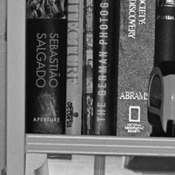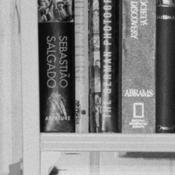@Crysist, Adox has discontinued CMS 20 II. I believe you can still order some from fotoimpex, while supplies last.
In regards to POTA, which I have used over the years, and with CMS 20 II, it gives excellent results, coming close to what Adotech IV can do. Adotech IV is still the number one developer for CMS 20 II. I always expose it at EI 12.
Yep, I'm sadly aware (hence this thread)
Sadly it seems soon we might have an abundance of low-contrast developers for microfilms with fewer and fewer microfilms to use them on!
Yeah, that sucked, it was only $6 per roll too. I would have definitely been a repeat customer.
Same :C
There seems to be at least 3 types of low ISO non-traditional films still of limited availability.
Microfilms for copying documents (Agfa, production discontinued) - CMS20 II and Agfa Copex Rapid.
Aerial surveillance films (Agfa and others, still in production) Aviphot 80 and derivatives.
Films for archiving movies (Kodak, Fuji, still in production) eg Kodak 2238, Fuji Eterna RDS 4791,also Kodak SO-331 (discontinued?).
I guess Fuji HR-21 is still an option, boasting similar specs to CMS 20 II, but it lacks perforations. I wonder how Kodak 2238 would do, though.
That are just different expressions for the same subject: A film (or film-developer combination) that delivers a full tonal scale from deep black, over all grey tones in-between to a bright white.
So if you photograph whith such a film e.g. a 20-step stepwedge, you will get full black, all grey tones from very dark to very bright grey, and full bright white.
And the optimal case is that this film renders these 20 steps exactly like the original, with the same brightness difference between the steps like the original.
Halftone is referring to the same thing? Being able to represent intermediate shades? I thought it meant it would specifically represent it in a halftone-like pattern, as opposed to having a smooth gradient. Those terms seemed to oppose each other when talking about printing, with "halftoning" being a compromising step because of the lack of any mid-tone inks.
But they're really just the same thing?
In general it is the same technology behind it. It is just that SPUR Dokuspeed SL-N is optimized for Agfa Copex Rapid / SPUR DSX, and ADOTECH IV is optimized for ADOX CMS 20 II.
There are no differences in the general targets. And both companies are cooperating.
Oh, that's fascinating! The technologies these companies have pioneered have been so cool, especially now having learned so much more about SPUR (and gigabitfilm) in this thread! That's part of the reason why the announcement was upsetting because I didn't want this fantastic work to fade away
They are indeed. Decades of R&D lead to these developers.
POTA was apparently developed to capture a range of exposures that'd occur during a nuclear test. There's another formula people use that's apparently better but Adotech seems to stand at another level. On that note, have you experimented with any other uses for them? Seeing as I may have an excess very soon, I wonder what other case would be fun to try.
SPUR is also offering a dedicated developer (Nanotech UR) for their lower speed Ultra R 800 ultra-high resolution microfilm.
Is that film also produced by AGFA or MACO and being discontinued soon too?
Personally I care for an optimal characteristic curve / tonality with sufficient shadow detail, therefore I am using CoRa / Dokuspeed SL at E.I. 25/15°, and CMS 20 II / ADOTECH IV with E.I 3/6° to 6/9° when I am working with a tripod, and E.I. 12/12° handheld (often with a manually reduced fill-in flash).
I've gravitated towards this very quickly when shooting negative film. With the addition of all the juicy language used for the results of rating film slower (
thick, dense, fat, beefy, etc) and avoiding the muddiness with underexposing, I only see benefits. Or at least punching things up by developing longer seems good too. Anything to avoid underexposure for what the film is rated. Can you push these developers as well?
No! It has absolutely nothing to do with their Aviphot Pan line. Completely different films. Agfa Copex Rapid is a microfilm.
The Agfa Aviphot Pan films are all super-panchromatic with extended red sensitivity (red is recorded brighter). And the Agfa microfilms are ortho-panchromatic with less red sensitivity (red is recorded darker compared to normal panchromatic films).
The characteristic curves are also very different, and the resolution as well.
No, no, no!!
See explanation above.
Sorry about that, I must have misremembered some of the conjecture I saw on here about the Aviphot films!
Agfa has stopped the production of microfilms, which were produced for Imagelink.
The production of aerial films has not stopped (at least so far).
Fingers crossed! I saw a comparison between a large format B&W photo from an aerial survey and later systems and
it was funny how drastic the difference was. Of course, large format would do that anyway, but B&W can resolve better more easily. Oh, hey! "Wild", the company Bertele from Zeiss worked for and
made that super special Biogon predecessor for! (I love this article)
In the graphic arts/commercial printing world, one used halftone techniques to create apparent continuous tone images when using printing technologies with monochrome or tri-colour ink.
If you see the phrase "pictorial halftone photography", the user of the phrase is at least associated with the printing or publishing world.
I see. But it's not referring to anything
different from any other films, right? Not to differentiate it from other films' HD curves' in any way?
I confused or kind of worried seeing that term used in photography because I always feel like it's referring to something entirely unique and I never knew what it meant in photography.
Thank you all for your help!












